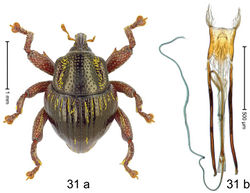Trigonopterus impressicollis
| Notice: | This page is derived from the original publication listed below, whose author(s) should always be credited. Further contributors may edit and improve the content of this page and, consequently, need to be credited as well (see page history). Any assessment of factual correctness requires a careful review of the original article as well as of subsequent contributions.
If you are uncertain whether your planned contribution is correct or not, we suggest that you use the associated discussion page instead of editing the page directly. This page should be cited as follows (rationale):
Citation formats to copy and paste
BibTeX: @article{Riedel2019ZooKeys, RIS/ Endnote: TY - JOUR Wikipedia/ Citizendium: <ref name="Riedel2019ZooKeys">{{Citation See also the citation download page at the journal. |
Ordo: Coleoptera
Familia: Curculionidae
Genus: Trigonopterus
Name
Trigonopterus impressicollis Riedel sp. n. – Wikispecies link – ZooBank link – Pensoft Profile
Diagnostic description
Holotype, male (Fig. 31a). Length 2.26 mm. Color of antennae, legs, and elytral humeri ferruginous; remainder black. Body subovate; in dorsal aspect with moderate constriction between pronotum and elytron; in profile dorsally convex. Rostrum dorsally with median carina and pair of submedian ridges; intervening furrows with sparse, erect scales; epistome short, posteriorly with transverse ridge. Pronotum with lateral edges weakly converging, with weak subapical constriction; disk with pair of distinct longitudinal impressions, lined with yellow elongate scales; medially broadly swollen, densely punctate, interspaces subglabrous, with narrow median costa. Elytra sparsely punctate with minute punctures; striae marked by impressed lines; in basal 1/3 and subapically with sparse yellow recumbent scales. Femora dentate, with acute tooth; anteroventral ridge of metafemur crenate. Metafemur with dorsoposterior edge weakly denticulate; subapically with stridulatory patch. Meso- and metatibia subbasally slightly widened, dorsal edge serrate. Metatibia curved. Abdominal ventrites 1–2 concave, subglabrous, sparsely punctate, with few scattered piliform scales; ventrite 5 concave, punctate, with sparse erect setae. Penis (Fig. 31b) with sides of body subparallel; apex subtruncate, laterally with tufts of long curly setae; apodemes 4.0 × as long as body of penis; transfer apparatus flagelliform, 3.5 × longer than body of penis; ductus ejaculatorius with indistinct bulbus. Intraspecific variation. Length 1.90–2.38 mm. Color of elytra ferruginous, partly ferruginous, or black. Female rostrum slender, dorsally in apical 1/2 subglabrous, with submedian row of punctures and with pair of sublateral furrows.
Material examined
Holotype (MZB): ARC3222 (GenBank # MK260468), S-Sulawesi Prov., Mangkutana, 02°20.203'S 120°46.878'E, 903 m, sifted, 14-V-2013. Paratypes (MZB, SMNK): S-Sulawesi Prov.: 14 exx, ARC3223 (GenBank # MK260472), ARC3224 (GenBank # MK260471), ARC6042 (GenBank # MK260470), ARC6043 (GenBank # MK260469), same data as holotype.
Distribution
S-Sulawesi Prov. (Mangkutana). Elevation ca. 900 m.
Biology
In leaf litter of montane forest.
Etymology
This epithet is an adjectival combination of the Latin participle impressus, -a, -um (imprinted), the noun collum (neck), and the second adjectival declension ending -is, and refers to the pair of impressions on the pronotum.
Notes
Trigonopterus impressicollis Riedel, sp. n. was coded as “Trigonopterus sp. 491”.
Original Description
- Riedel, A; Narakusumo, R; 2019: One hundred and three new species of Trigonopterus weevils from Sulawesi ZooKeys, (828): 1-153. doi
Images
|
